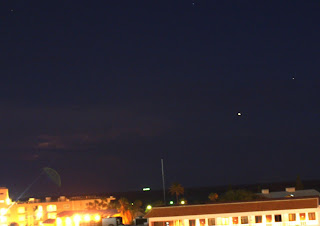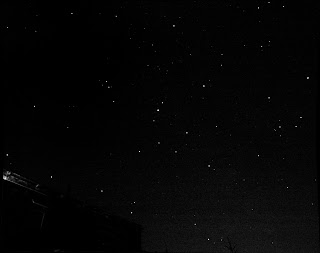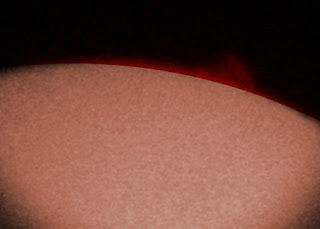September 2013
Sept 29th
I bin scanned the Sun at 1015 GMT but didn't see any sunspots.
Sept 26th
An early morning solar bin scan revealed new sunspot activity, with 3 easily visible.
Sept 23rd 0000 GMT
It looked clear enough, so I decided to try other camera settings to try and improve on my Scorpius and Sagittarius shots. Although it wasn't apparent visually, conditions deteriorated quite rapidly. Only the first Scorpius frame was worth trying at all, although the second one did show the constellation and the Sagittarius shots (all ten of them!) showed hardly anything at all.
Sept 23rd 1140 GMT
A solar bin scan showed that the single large sunspot had rotated a long way very quickly.
Sept 22nd 0100 GMT
I went up to the top to have another go at Scorpius and Sagittarius again. I also took my binoculars to have a look round.
Sagittarius showed many more stars than the day before, that the constellation pattern was lost. Scorpius had most of the constellation covered in haze, apart from the tail.
The disappointment with the photos was in contrast to my binocular scan. I'd seen M6 and M7 (open clusters) from the UK before but they were much better from Aruba.Neither M4 nor M80 were spectacular either but were easier to see. The Wild Duck Cluster (M11) looked rather nice but no better than it does from England. In contrast M22, M8, M20, M24 and M25 looked somewhat better and I could also see M26 as well. The summer double stars in Lyra, Cygnus and Draco showed well, as did Alpha Capricornii (visible sometimes from southern England but far from easy.
Finally, a reddish Moon was rising in the east and showed some of the southern craters.
Sept 22nd 2050 GMT
Six minutes into autumn, I check the Sun with my binoculars again and saw a single large sunspot that had rotated a bit further.
Sept 21st 0110 GMT
I replaced the camera battery and had another go at the scorpion's tail but I didn't catch it again. Neither Lyra nor Cygnus worked. Despite the cloud, I managed not only to capture Sagittarius but also Corona Austrinus, although it was somewhat obscured. I managed a snap of Piscis Austrinus (very difficult from the UK) and Grus, which never rises at all from the UK.
Sept 21st 0045 GMT
With Moon and cloud, it was not a night for constellation photography but I had to have a go, as Scorpius was visible. I managed a result from two shots out of 5 and a lot of clean up. Attempts at Sagittarius and Lyra failed.
Sept 21st 2220 GMT
I was returning from the beach when I noticed that I could see Venus before sunset.
Sept 21st 1800 GMT
A solar bin scan showed that the Sun had rotated from the day before.
Sept 20th 0115 GMT
Most of the sky was covered by cloud. I took a look at the Moon and it was waning gibbous, showing Tycho's rays very clearly.
Sept 20th 2120 GMT
A solar bin scan revealed a single large sunspot that had either rotated into view or just formed.
September 20th
I did another photo that looked like it was of Mars but it was a sneakily adjusted photo of a beach in Aruba.
Sept 19th 1155 GMT
I bin scanned the Sun early in the morning and saw new sunspot activity. A large sunspot had emerged but was close to rotating off almost as soon as it was formed.September 18th 0100 GMT
My main intended target was Scorpius but there was a tropical storm brewing, which was illuminating some low cloud. My best shot included Venus and Saturn and the next best just Venus.
The good news was that I managed to catch Scorpius, including the tail. The bad news was that the cloud really messed it up and I hoped for a chance I might manage to better another time!
The last photo was a DSLR shot of the Moon composed of 21 individual shots.
September 17th 0000 GMT
There was too much cloud to attempt any constellation shots but I managed to capture the conjunction of Venus and Saturn, with Arcturus to the right. I also managed to get the phase of Venus using just a DSLR and a lot of processing to get rid of the false colour.
September 17th 2200 GMT
I snapped the Moon with my DSLR and captured the main "seas".
September 17th
I reprocessed a solar hydrogen alpha photograph from September 27th 2011.
Sept 16th 2300 GMT
After nightfall, there was lots of moving cloud, discouraging me from making any attempt at photography.
The Moon showed well at about 9 days since full. The southern craters were past their best but Tycho’s rays were already dominating the moonscape.
Venus and Saturn were close (I mistook Saturn for Spice at first!!). Venus showed a phase of about 65% and Saturn showed a hint of rings.
The Moon showed well at about 9 days since full. The southern craters were past their best but Tycho’s rays were already dominating the moonscape.
Venus and Saturn were close (I mistook Saturn for Spice at first!!). Venus showed a phase of about 65% and Saturn showed a hint of rings.
Sept 16th 2100 GMT
After my first day teaching in Aruba, I bin scanned the Sun but didn’t see any sunspots, although a small one was visible on the Big Bear images.
Sept 10th 2115 GMT
I took some shots of Perseus while browsing the sky with binoculars.Melotte 20 looked great and M34 showed, despite low elevation. The Andromeda Galaxy (M31) showed structure and I could just make out the Pinwheel (M33). I also potted the Perseus Double Cluster. To the west I saw the Wild Duck cluster (M11). I also saw M15 and M2, although the latter was low and faint. The Milky Way around Cygnus was sparkling and I almost missed Albireo.
In fact, I was really pleased with the stack of ten 30 second exposures because I also caught the faint imprints of the Andromeda Galaxy (M31) and Perseus Double cluster.
Sept 9th 1450 GMT
I checked the Sun again but didn't see any activity.
Sept 8th 1720 GMT
I checked the Sun with my filters and binoculars but did not see any sunspots.
Sept 7th 2210 GMT
I
went out to a clear sky and did some constellation shots. I started with
Hercules, took a 90 second exposure of Ursa Minor, 50 second exposure of
Perseus, then 10 thirty second exposures of Cassiopeia and a dark frame.
The Perseus frame had camera shake but the rest worked well.
Sept 7th 0755
I
bin scanned the Sun at 0755 GMT and didn’t see any sunspots, despite the clear conditions.
Sept 5th 1040 GMT
I checked the Sun with my PST and saw that the activity was less than the day before. There were some small prominences and the surface detail was concentrated in a smaller area.Sept 5th 0750 GMT
A solar binocular scan showed that the sunspots were close to rotating off of the disc.Sept 4th 2110 GMT
I did some frames of Pegasus and Aquila before bedtime. Although they turned out quite well, it was not possible to stack them.Sept 4th 1710 GMT
The Sun looked quite splendid in my PST showing lots of plages and filaments, although not the prominences of the day before. Unfortunately the photos didn't show so much, unlike the day before, and the best result was a composite stitched from 15 images with another shot used to show the prominence.Sept 4th 1135 GMT
A solar binocular scan suggested a rather quieter Sun than the day before.Sept 3rd 1110 GMT
I checked the Sun with my PST. In addition to the surface detail, there was a large prominence to the south (top). I took several shots at different magnifications to see what I could record.Sept 3rd 0920 GMT
I checked the Sun with my binoculars in much clearer conditions and saw more sunspots.Sept 2nd 1545 GMT
I checked the Sun in hydrogen alpha light and there was lots of disc activity, even though the prominences were smaller. There was no sign of prominences on the photos but the filaments showed very well.Sept 2nd 0710 GMT
A morning binocular scan of the Sun showed a single sunspot in the centre of the disc.Sept 1st 1050 GMT
The hazy conditions continued into the day but I was able to see sunspots through my binoculars.Sept 1st 2350 GMT
I tried some shots of Pegasus but the hazy conditions didn't produce many stars. Still, I managed two mosaics of the region.Sept 1st 2320 GMT
Conditions didn't look too promising but I was able to make out the Pleiades (M45) quite easily and the Andromeda Galaxy (M31) through 15x70 binoculars. Melotte 20 showed particularly well, although M15 was marginal.
























































